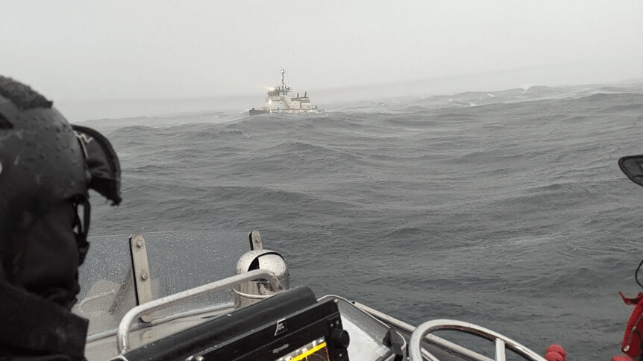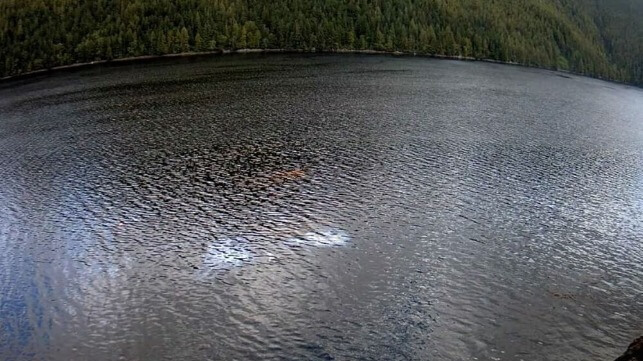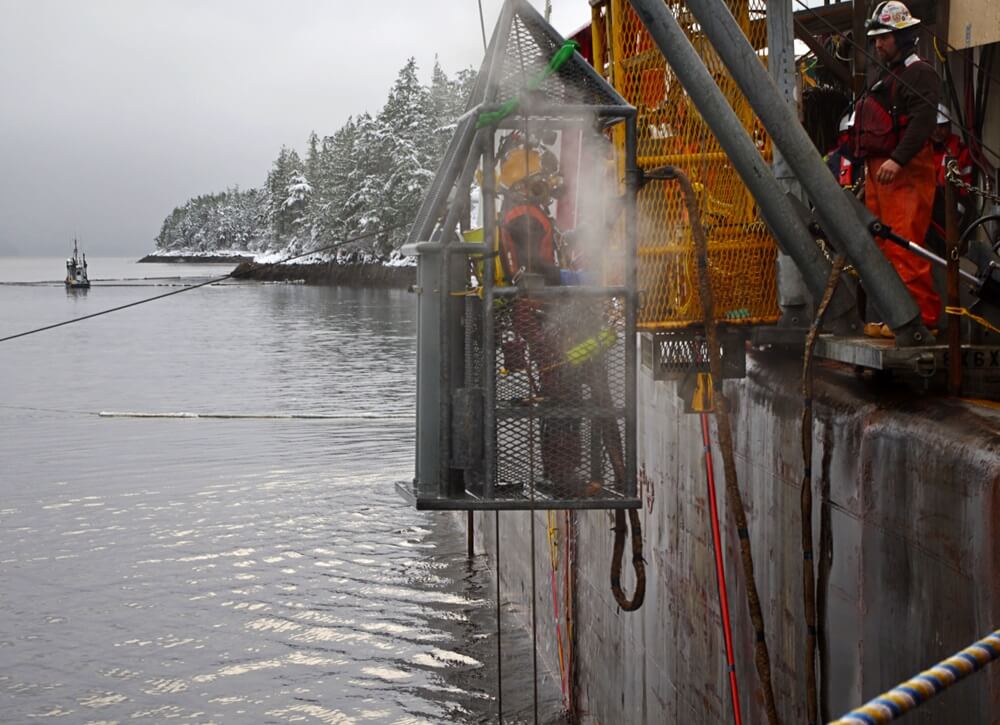Canadian Rescue Ship Saves Drifting Tug From Grounding off Washington

On Friday, a combined U.S. Coast Guard and Canadian Coast Guard response team narrowly prevented a tug from going aground off La Push, Washington in rough weather.
At about 1600 hours on Friday, the 130-foot tug Luther was towing a concrete barge about 10 miles off the coast of La Push when it lost steering. The crew called the Coast Guard for help, and a motor lifeboat crew from Coast Guard Station Quillayute River, a helicopter aircrew from Coast Guard Air Station Astoria, and the emergency response tug Lauren Foss were dispatched to assist. The surface conditions on scene included seas of 10–14 feet and 45 knots of wind. Lacking steerage, the crew of the Luther attempted to keep the bow of their vessel into the seas using their twin-screw propulsion.
The situation aboard the Luther deteriorated in the rough weather, and the tug began taking on water. In order to save their vessel, the crew disconnected from their tow, and they were able to stabilize the situation while awaiting first responders.
The Lauren Foss soon arrived and began to prepare to take the Luther in tow to a port of refuge - but as they were getting ready, the drifting barge came so close that the crew feared that there was a risk of collision. All crewmembers transferred over to the motor lifeboat for safety, but in the heavy swells, one person fell in the water while making the transfer. The motor lifeboat crew managed to retrieve them from the seas.
The Luther was drifting towards shore, and to prevent a grounding, the motor lifeboat crew put a coastguardsman back aboard the tug to help attempt a tow. After making a connection, the Lauren Foss attempted to tow the disabled tug to safety - but a line fouled in one of Lauren Foss' props, forcing the tug to return to port.
The Canadian Coast Guard emergency response tug Atlantic Raven was stationed nearby on the west coast of Vancouver Island, and it diverted to assist. The Raven arrived in the early hours of Saturday morning, along with additional U.S. Coast Guard assets from Neah Bay and Port Angeles.
With the CCG's help, the U.S. Coast Guard crews set up a tow, and the Atlantic Raven kept the drifting Luther off the beach. They narrowly averted a grounding, as the tug had come within one mile of shore.
The Luther was towed safely to Port Angeles, and the crew all returned to shore without injuries.
The barge remained missing, and the Coast Guard set up a unified command with the owner, the state department of ecology and the local Makah Tribe to manage the risk of a spill. The barge is carrying 10,000 tons of cement mix and 1,200 gallons of diesel fuel, and search crews hunted for it throughout Saturday in heavy seas, high winds and low visibility. The service announced that the barge had been found on Saturday evening, and the responders began operations to tow it to a safe harbor.
Atlantic Raven is one of two anchor handling tugs that the Canadian Coast Guard chartered in 2018 to manage the risk of a major casualty off the seaward coast of Vancouver Island, where busy shipping lanes coincide with rough winter weather rolling in from the North Pacific. The Raven and sister ship Atlantic Eagle have about 160 tonnes of bollard pull, twice that of a typical harbor tug, and bring the heavy-weather capabilities of a 250-foot oceangoing AHTS design.
Luther is a 49-year-old, 3000-horsepower twin screw tug operated by a firm in Seattle, and is among the youngest vessels in the owner's listed fleet.
In July 2023, Coast Guard inspectors found a leaking steering ram in Luther's steering compartment and ordered it repaired. Five days later, the vessel "was unable to properly maneuver during underway drills." The vessel also reported a hairline crack in the rub rail, causing diesel fuel leakage. These and other deficiencies were corrected to the Coast Guard's satisfaction.
Resolve Marine Hired to Remove Oil From WWII Wreck in Grenville Channel

The Canadian government has awarded a contract to Resolve Marine to remove oil fom the WWII-era shipwreck USAT Brigadier General M.G. Zalinski, which grounded and sank in Grenville Channel on B.C.'s Inside Passage almost 80 years ago. It is the latest of several attempts that environmental protection agencies have made to reduce the risk of a fuel leak from the Zalinski, which has been on the bottom since 1946 and is gradually deteriorating.
The Zalinski was a freighter built in 1919, and was acquired by the War Department at the outset of World War II. After the war ended, she continued serving the military as a cargo vessel on the West Coast. On September 29, 1946, the Zalinski was headed from Seattle to Whittier with a cargo of ammunition and fuel oil when she hit a rock in Grenville Channel, the deep and narrow strait between Pitt Island and mainland British Columbia. Miraculously, all 48 members of her crew were rescued by good Samaritan vessels.
The wreck was largely forgotten until 2003, when a U.S. Coast Guard cutter spotted a slick on the surface near Lowe Inlet, a small provincial park about halfway up the channel. After a month-long search, a Canadian Coast Guard ROV survey found a wreck site located south of the inlet in about 100 feet of water. The hull was identified as the Zalinski.
The ship's fuel oil and explosive cargo were not immediately addressed, and the vessel repeatedly released fuel as it continued to deteriorate. In 2013, the Canadian Coast Guard hired a remediation team to remove 600 tonnes of oil from the Zalinski, with a budget of CA$50 million and a 100-person crew.

Commercial divers at work at the Zalinski wreck site, 2013 (CCG)
The work site is difficult, with five-knot tidal currents that interfere with dive operations, and the shipwreck is upside down and perched on the edge of a steep underwater cliff. Ultimately, the salvors only managed to recover a fraction of the fuel on board because the tanks had collapsed internally, allowing the oil to migrate within the vessel's hull and accumulate in pockets. Return visits in 2015 and 2018 recovered small additional amounts, but pockets remained in inaccessible locations.
 The Zalinski's wreck is upside down, perched on a sloping underwater shelf on the steep channel edge (CCG)
The Zalinski's wreck is upside down, perched on a sloping underwater shelf on the steep channel edge (CCG)
In recent years, the ship’s structure has continued to deteriorate, and some of the remaining fuel tanks have collapsed. According to the Canadian Coast Guard, the deterioration poses a substantial risk of releasing a large amount of oil. At present, only a "minimal" amount of fuel is leaking out from the vessel, and the CCG's concern is for preventing a future spill.
For this round of cleanup, Resolve Marine has been contracted for a CA$4.9 million remediation project using hot tapping. The objective is to recover as much remaining oil as possible while minimizing the risk of leakage, and CCG spill-control assets are staged nearby as a precautionary measure given the small but possible risk of a release during operations. The work is scheduled to begin in mid-October and is expected to take several weeks; in comments to CBC, the Canadian Coast Guard acknowledged that it may be necessary to return again in future years.
No comments:
Post a Comment